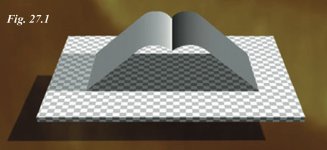MartinDCZ
Active member

Hello folks,
Been a long time since I was here last.
I've come in search of an advice from more experienced binocular users that I haven't been able to find so far.
As I've been using my Endeavor EDII 8x42 extensively since the day I got it, I noticed the usual downsides of this particular design (lack of 3D perception, rolling ball, diffraction spikes...), but it took long time to notice one particular phenomenon.
As a lot of the observed objects (and I'd imagine this would especially be true for birders) are of irregular or asymmetrical shapes, it may evade notice.
How I even noticed it in first place was peculiar too; I was watching from above some OB trucks departing from garages.
Naturally, when you watch that kind of box-shaped object, the parts that are further from you appear smaller, even though you know the box-shaped object has the same height, depth and width throughout.
That's what creates the 3D perception.
But when viewed through the ED II, this perception is changed. The binocular projected the box-shaped truck with what appeared to be a sort of 'orthographic' view, rather than a perspective view:
https://www.google.cz/search?biw=19...k1j0i30k1.0.Cjj6DxsZots#imgrc=J8n5dlMQdIv4JM:
That is, if the dimensions are equal, the ED II shows them as equal, regardless of the angle of attack, the small, but still non-zero relative distance...
My other pair of binoculars (Nikon Aculon 16x50) is ridden with multitude of other flaws, but it simply doesn't do that.
The rolling ball effect is something that's not very kind to my eyes but I kind of got used to that. The unnatural view rid of 3D perception however (which I think has a lot more to do with the orthographic projection rather than the roof-prism construction - hence the objective lenses not being far apart enough) is kind a hard blow.
Now, I know that obviously some field flatteners are more equal than others, but I wonder if this phenomenon is, to some extent, typical to all binoculars with field flattener lenses.
If so, I think I'll want to avoid them from now. I'd much prefer binoculars that have a natural, three dimensional, perspective view, don't confuse my brain when panned and have a wide AFOV with a reasonable part of it in focus, rather than all of it sharp, but at a steep price of an image that doesn't make sense.
Thanks in advance.
Martin
Been a long time since I was here last.
I've come in search of an advice from more experienced binocular users that I haven't been able to find so far.
As I've been using my Endeavor EDII 8x42 extensively since the day I got it, I noticed the usual downsides of this particular design (lack of 3D perception, rolling ball, diffraction spikes...), but it took long time to notice one particular phenomenon.
As a lot of the observed objects (and I'd imagine this would especially be true for birders) are of irregular or asymmetrical shapes, it may evade notice.
How I even noticed it in first place was peculiar too; I was watching from above some OB trucks departing from garages.
Naturally, when you watch that kind of box-shaped object, the parts that are further from you appear smaller, even though you know the box-shaped object has the same height, depth and width throughout.
That's what creates the 3D perception.
But when viewed through the ED II, this perception is changed. The binocular projected the box-shaped truck with what appeared to be a sort of 'orthographic' view, rather than a perspective view:
https://www.google.cz/search?biw=19...k1j0i30k1.0.Cjj6DxsZots#imgrc=J8n5dlMQdIv4JM:
That is, if the dimensions are equal, the ED II shows them as equal, regardless of the angle of attack, the small, but still non-zero relative distance...
My other pair of binoculars (Nikon Aculon 16x50) is ridden with multitude of other flaws, but it simply doesn't do that.
The rolling ball effect is something that's not very kind to my eyes but I kind of got used to that. The unnatural view rid of 3D perception however (which I think has a lot more to do with the orthographic projection rather than the roof-prism construction - hence the objective lenses not being far apart enough) is kind a hard blow.
Now, I know that obviously some field flatteners are more equal than others, but I wonder if this phenomenon is, to some extent, typical to all binoculars with field flattener lenses.
If so, I think I'll want to avoid them from now. I'd much prefer binoculars that have a natural, three dimensional, perspective view, don't confuse my brain when panned and have a wide AFOV with a reasonable part of it in focus, rather than all of it sharp, but at a steep price of an image that doesn't make sense.
Thanks in advance.
Martin






